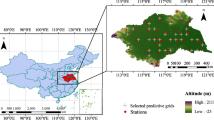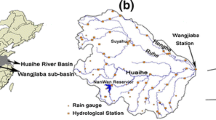Abstract
Coupled hydrological and atmospheric modeling is an effective tool for providing advanced flood forecasting. However, the uncertainties in precipitation forecasts are still considerable. To address uncertainties, a one-way coupled atmospheric-hydrological modeling system, with a combination of high-resolution and ensemble precipitation forecasting, has been developed. It consists of three high-resolution single models and four sets of ensemble forecasts from the THORPEX Interactive Grande Global Ensemble database. The former provides higher forecasting accuracy, while the latter provides the range of forecasts. The combined precipitation forecasting was then implemented to drive the Chinese National Flood Forecasting System in the 2007 and 2008 Huai River flood hindcast analysis. The encouraging results demonstrated that the system can clearly give a set of forecasting hydrographs for a flood event and has a promising relative stability in discharge peaks and timing for warning purposes. It not only gives a deterministic prediction, but also generates probability forecasts. Even though the signal was not persistent until four days before the peak discharge was observed in the 2007 flood event, the visualization based on threshold exceedance provided clear and concise essential warning information at an early stage. Forecasters could better prepare for the possibility of a flood at an early stage, and then issue an actual warning if the signal strengthened. This process may provide decision support for civil protection authorities. In future studies, different weather forecasts will be assigned various weight coefficients to represent the covariance of predictors and the extremes of distributions.
Similar content being viewed by others
References
Bao H J, Zhao L N, He Y, Li Z J, Wetterhall F, Cloke H L, Pappenberger F, Manful D (2011). Coupling ensemble weather predictions based on TIGGE database with Grid-Xinanjiang model for flood forecast. Adv Geosci, 29: 61–67
Bartholmes J, Thielen J, Ramos M, Gentilini S (2008). The European Flood Alert System EFAS–Part 2: statistical skill assessment of probabilistic and deterministic operational forecasts. Hydrol Earth Syst Sci Discuss, 5(1): 289–322
Benoit R, Desgagné M, Pellerin P, Pellerin S, Chartier Y, Desjardins S (1997). A semi-lagrangian, semi-implicit wide-band atmospheric model suited for fine scale process studies and simulation. Mon Weather Rev, 125(10): 2382–2415
Benoit R, Schär C, Binder P, Chamberland S, Davies H C, Desgagné M, Girard C, Keil C, Kouwen N, Lüthi D, Maric D, Müller E, Pellerin P, Schmidli J, Schubiger F, Schwierz C, Sprenger M, Walser A, Willemse S, Yu W, Zala E (2001). The real-time ultrafine scale forecast support during the special observing period of the MAP. Bull Am Meteorol Soc, 83(1): 985–1009
Bishop C H, Etherton B J, Majumdar S J (2001). Adaptive sampling with the ensemble transform Kalman filter Part I: theoretical aspects. Mon Weather Rev, 129(3): 420–436
Bourke W, Buizza R, Naughton M (2004). Performance of the ECMWF and the BoM ensemble prediction systems in the Southern Hemisphere. Mon Weather Rev, 132(10): 2338–2357
Brankovic C, Palmer T N, Molteni F, Tibaldi S, Cubasch U (1990). Extended-range predictions with ECMWF models: time-lagged ensemble forecasting. Q J R Meteorol Soc, 116(494): 867–912
Buizza R, Palmer T N (1995). The singular-vector structure of the atmospheric global circulation. J Atmos Sci, 52(9): 1434–1456
Côté J, Gravel S, Méthot A, Patoine A, Roch M, Staniforth A (1998). The operational CMC-MRB Global Environmental Multiscale (GEM) model Part I: design considerations and formulation. Mon Weather Rev, 126(6): 1373–1395
Dalcher A, Kalnay E, Hoffman R N (1988). Medium range lagged forecasts. Mon Weather Rev, 116(2): 402–416
Davolio S, MigliettaMM, Diomede T, Marsigli C, Montani A (2012). A flood episode in Northern Italy: multi-model and single-model mesoscale meteorological ensembles for hydrological predictions. Hydrol Earth Syst Sci, 9(12): 13415–13450
Davolio S, Miglietta M M, Diomede T, Marsigli C, Morgillo A, Moscatello A (2008). A meteo-hydrological prediction system based on a multi-model approach for precipitation forecasting. Nat Hazards Earth Syst Sci, 8(1): 143–159
Diomede T, Davolio S, Marsigli C, Miglietta M M, Moscatello A, Papetti P, Paccagnella T, Buzzi A, Malguzzi P (2008b). Discharge prediction based on multi-model precipitation forecasts. Meteorol Atmos Phys, 101(3–4): 245–265
Diomede T, Marsigli C, Nerozzi F, Papetti P, Paccagnella T (2008a). Coupling high-resolution precipitation forecasts and discharge predictions to evaluate the impact of spatial uncertainty in numerical weather prediction model outputs. Meteorol Atmos Phys, 102(1–2): 37–62
Erfani A, Méthot A, Goodson R, Bélair S, Yeh K S, Côté J, Moffet R (2003). Synoptic and mesoscale study of a severe convective outbreak with the nonhydrostatic Global Environmental Multiscale (GEM) model. Meteorol Atmos Phys, 82(1–4): 31–53
Froude L (2010). TIGGE: comparison of the prediction of northern hemisphere extratropical cyclones by different ensemble prediction systems. Weather Forecast, 25(3): 819–836
Gill M A (1978). Flood routing by the Muskingum method. J Hydrol (Amst), 36(3–4): 353–363
Habets F, Noilhan J, Golaz C, Goutorbe J P, Lacarrère P, Leblois E, Ledoux E, Martin E, Ottlé C, Vidal-Madjar D (1999). The ISBA surface scheme in a macroscale hydrological model applied to the Hapex-Mobilhy area Part 1: model and database. J Hydrol (Amst), 217(1–2): 75–96
He Y, Wetterhall F, Cloke H L, Pappenberger F, Wilson M, Freer J, Mc Gregor G (2009). Tracking the uncertainty in flood alerts driven by grand ensemble weather predictions. Meteorol Appl, 16(1): 91–101
Krzysztofowicz R (2001). The case for probabilistic forecasting in hydrology. J Hydrol (Amst), 249(1–4): 2–9
Laprise R, Caya D, Bergeron G, Giguère M (1997). The formulation of the Andre Robert MC2 (Mesoscale Compressible Community) model. Atmos-ocean, 35(S1): 195–220
Li J, Zou Z L (2014). Impact of FY-3A MWTS radiances on prediction in GRAPES with comparison of two quality control schemes. Front Earth Sci, 8(2): 251–263
Liguori S, Rico-Ramirez M A (2013). A practical approach to the assessment of probabilistic flow predictions. Hydrol Processes, 27 (1): 18–32
Liu S Y, Gao W, Xu M, Wang X Y, Liang X Z (2009). China summer precipitation simulations using an optimal ensemble of cumulus schemes. Front Earth Sci, 3(2): 248–257
Liu Y, Duan Q, Zhao L, Ye A, Tao Y, Miao C, Mu X, Schaake J C (2013). Evaluating the predictive skill of post-processed NCEP GFS ensemble precipitation forecasts in China’s Huai River Basin. Hydrol Processes, 27(1): 57–74
Luo B K, Qian X W (1987). Some problems with Muskingum method. Hydrological Sciences Journal, 32(4): 485–496
Ma S, Qu A, Wang Y (2007). The performance of the new tropical cyclone track prediction system of the China National Meteorological Center. Meteorol Atmos Phys, 97(1–4): 29–39
Ma Z K, Fan Z W, Zhang M, Su Y L (2014). Flood risk control of dams and dykes in middle reach of Huaihe River. Water Science and Engineering, 7(1): 17–31
Noilhan J, Planton S (1989). A simple parameterization of land surface processes for meteorological models. Mon Weather Rev, 117(3): 536–549
Pan X D, Li X, Shi X K, Han X J, Luo L H, Wang L X (2012). Dynamic downscaling of near-surface air temperature at the basin scale using WRF—A case study in the Heihe River Basin, China. Front Earth Sci, 6(3): 314–323
Pappenberger F, Bartholmes J, Thielen J, Cloke H L, Buizza R, de Roo A (2008). New dimensions in early flood warning across the globe using grand-ensemble weather predictions. Geophys Res Lett, 35 (10): L10404
Pappenberger F, Stephens E, Thielen J, Salamon P, Demeritt D, van Andel S J, Wetterhall F, Alfieri L (2013). Visualizing probabilistic flood forecast information: expert preferences and perceptions of best practice in uncertainty communication. Hydrol Processes, 27(1): 132–146
Pappenberger F, Thielen J, Del MedicoM(2011). The impact of weather forecast improvements on large scale hydrology: analysing a decade of forecasts of the European Flood Alert System. Hydrol Processes, 25(7): 1091–1113
Park Y Y, Buizza R, Leutbecher M (2008). TIGGE: preliminary results on comparing and combining ensembles. Q J R Meteorol Soc, 134 (637): 2029–2050
Qaddouri A, Cote J, Valin M (2000). A parallel direct 3D elliptic solver. International Series in Engineering and Computer Science, 541: 429–442
Roebber P J, Schultz D M, Colle B A, Stensrud D J (2004). Toward improved prediction: high-resolution and ensemble modeling systems in operation. Weather Forecast, 19(5): 936–949
Rossa A, Liechti K, Zappa M, Bruen M, Germann U, Haase G, Keil C, Krahe P (2011). The COST 731 action: a review on uncertainty propagation in advanced hydro-meteorological forecast systems. Atmos Res, 100(2–3): 150–167
Si D, Ding Y H, Liu Y J (2009). Decadal northward shift of the Meiyu belt and the possible cause. Chin Sci Bull, 54(24): 4742–4748
Stensrud D J, Brooks H E, Du J, Tracton M S, Rogers E (1999). Using ensembles for short-range forecasting. Mon Weather Rev, 127(4): 433–446
Tanguay M, Robert A, Laprise R (1990). A semi-implicit semi- Lagrangian fully compressible regional forecast model. MonWeather Rev, 118(10): 1970–1980
Thielen J, Bartholmes J, Ramos M, de Roo A (2008). The European flood alert system–part 1: concept and development. Hydrol Earth Syst Sci Discuss, 5(1): 257–287
Thomas S J, Girard C, Benoit R, Desgané M, Pellerin P (1998). A new adiabatic kernel for the MC2 model. Atmos-ocean, 36(3): 241–270
Todini E (2004). Role and treatment of uncertainty in real-time flood forecasting. Hydrol Processes, 18(14): 2743–2746
Wei M, Toth Z (2003). A new measure of ensemble performance: perturbation versus error correlation analysis (PECA). Mon Weather Rev, 131(8): 1549–1565
Wen L, Yu W, Lin C A, Béland M, Benoit R, Delage Y (2000). The role of land surface schemes in short-range, high spatial resolution forecast. Mon Weather Rev, 128(10): 3605–3617
Xuan Y, Cluckie D, Wang Y (2009). Uncertainty analysis of hydrological ensemble forecasts in a distributed model utilising short-range rainfall prediction. Hydrol Earth Syst Sci, 13(3): 293–303
Yakimiw E, Robert A (1986). Accuracy and stability analysis of a fully implicit scheme for the shallow-water equations. Mon Weather Rev, 114(1): 240–244
Yu Z B, Yang T, Schwartz F W (2014). Water issues and prospects for hydrological science in China. Water Science and Engineering, 7(1): 1–4
Zhang S L (2006). Interactive correct technology for flood forecasting. Shui Kexue Jinzhan, 17(5): 653–657 (in Chinese)
Zhang Y Y, Shao Q X, Xia J, Bunn S E, Zuo Q T (2011). Changes of flow regimes and precipitation in Huai River Basin in the last half century. Hydrol Processes, 25(2): 246–257
Zhao L N, Qi D, Tian F Y, Wu H, Di J Y, Wang Z, Li A H (2012). Probabilistic flood prediction in the upper Huaihe catchment using TIGGE data. Acta Meteorol Sin, 26(1): 62–71
Zhao R J (1992). The Xinanjiang model applied in China. J Hydrol (Amst), 135(1–4): 371–381
Author information
Authors and Affiliations
Corresponding author
Rights and permissions
About this article
Cite this article
Wu, Z., Wu, J. & Lu, G. A one-way coupled atmospheric-hydrological modeling system with combination of high-resolution and ensemble precipitation forecasting. Front. Earth Sci. 10, 432–443 (2016). https://doi.org/10.1007/s11707-015-0535-2
Received:
Accepted:
Published:
Issue Date:
DOI: https://doi.org/10.1007/s11707-015-0535-2




